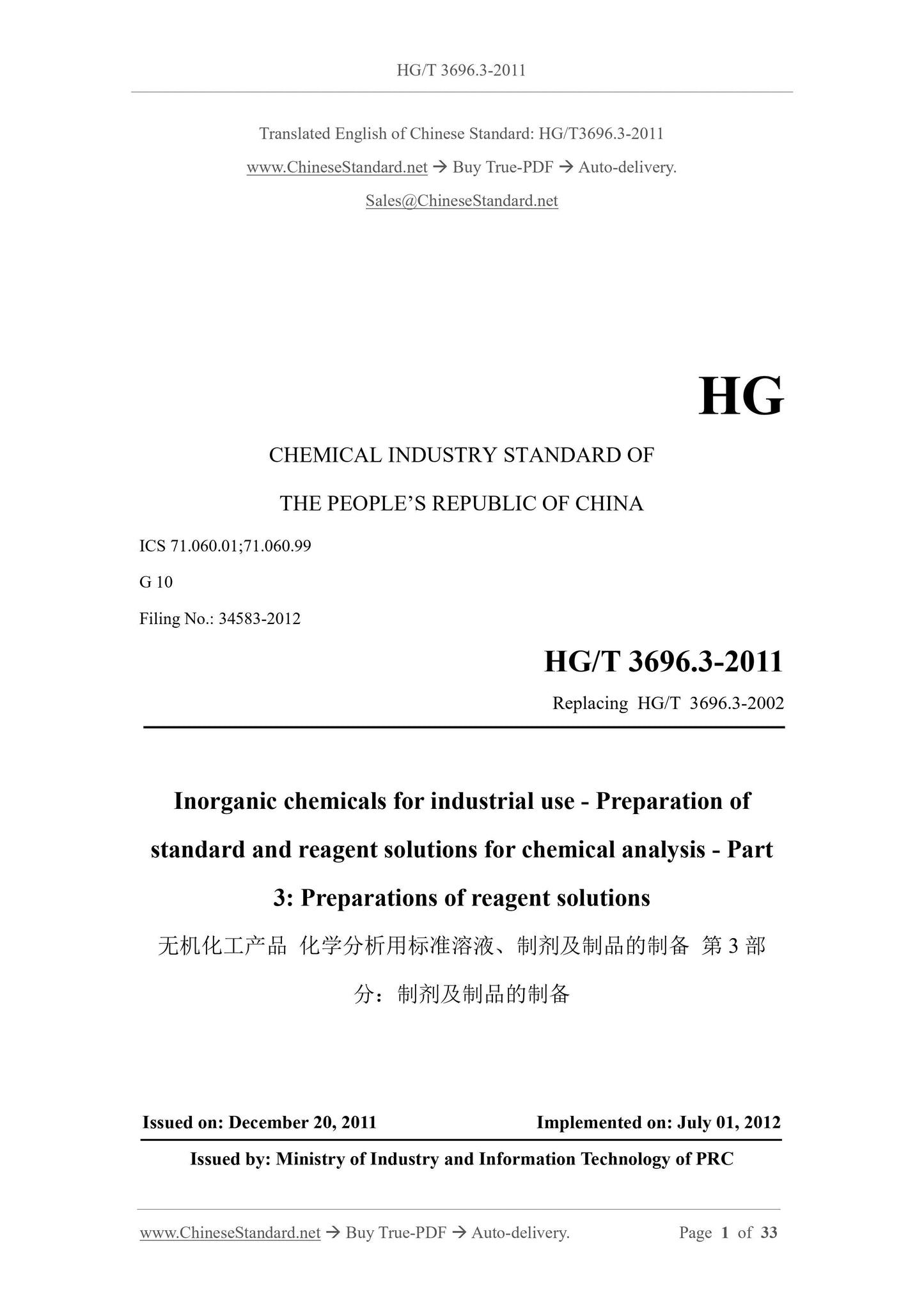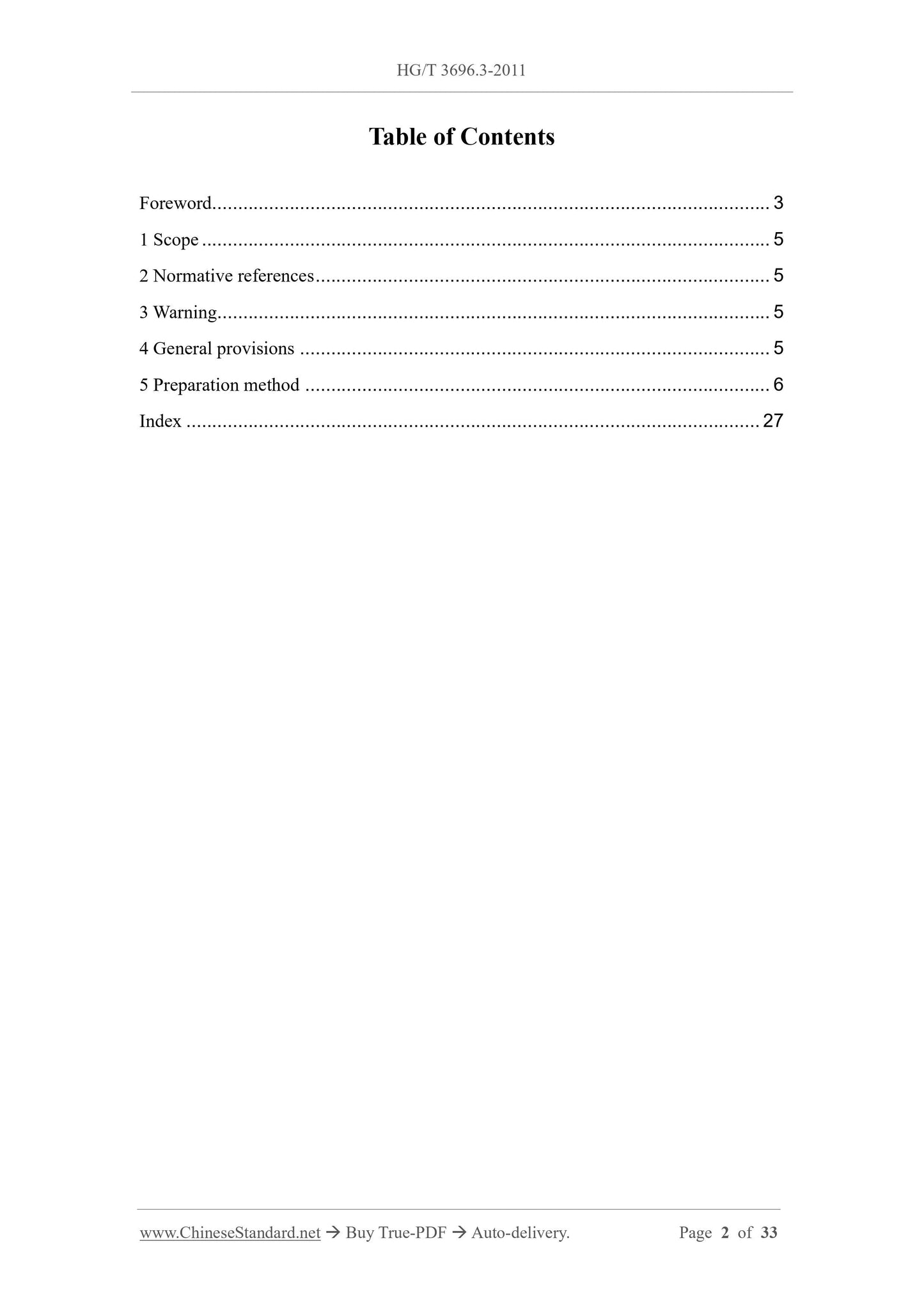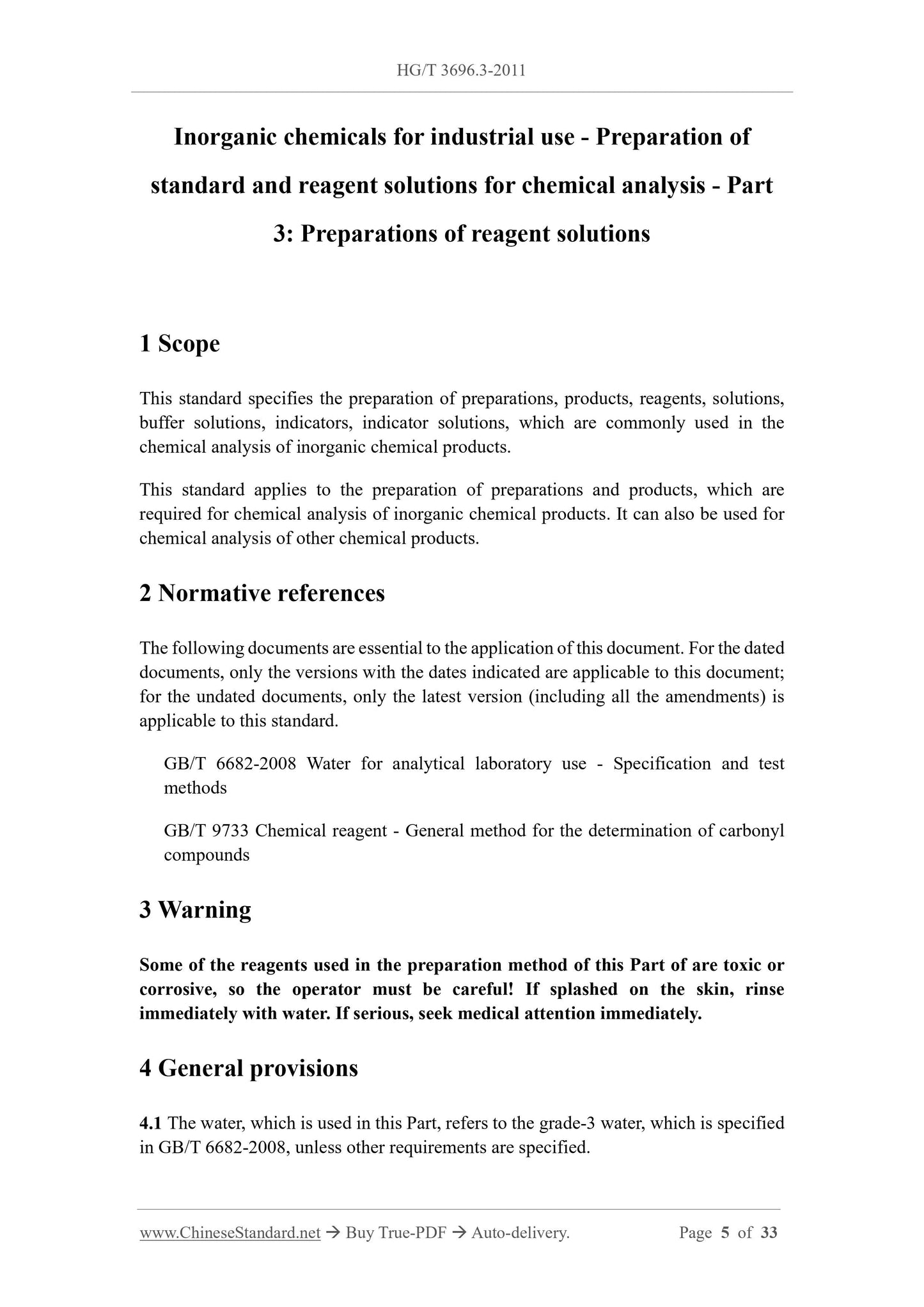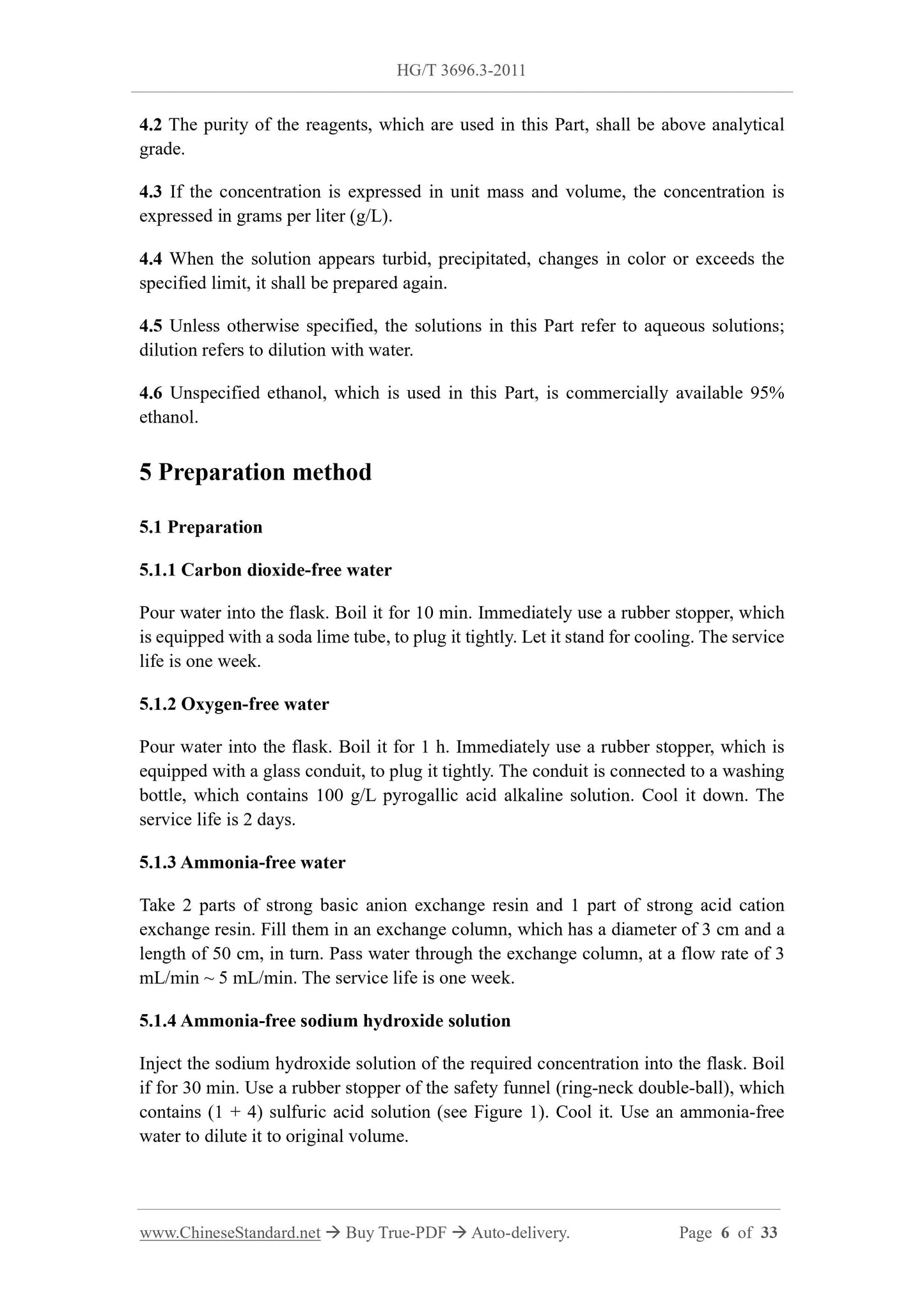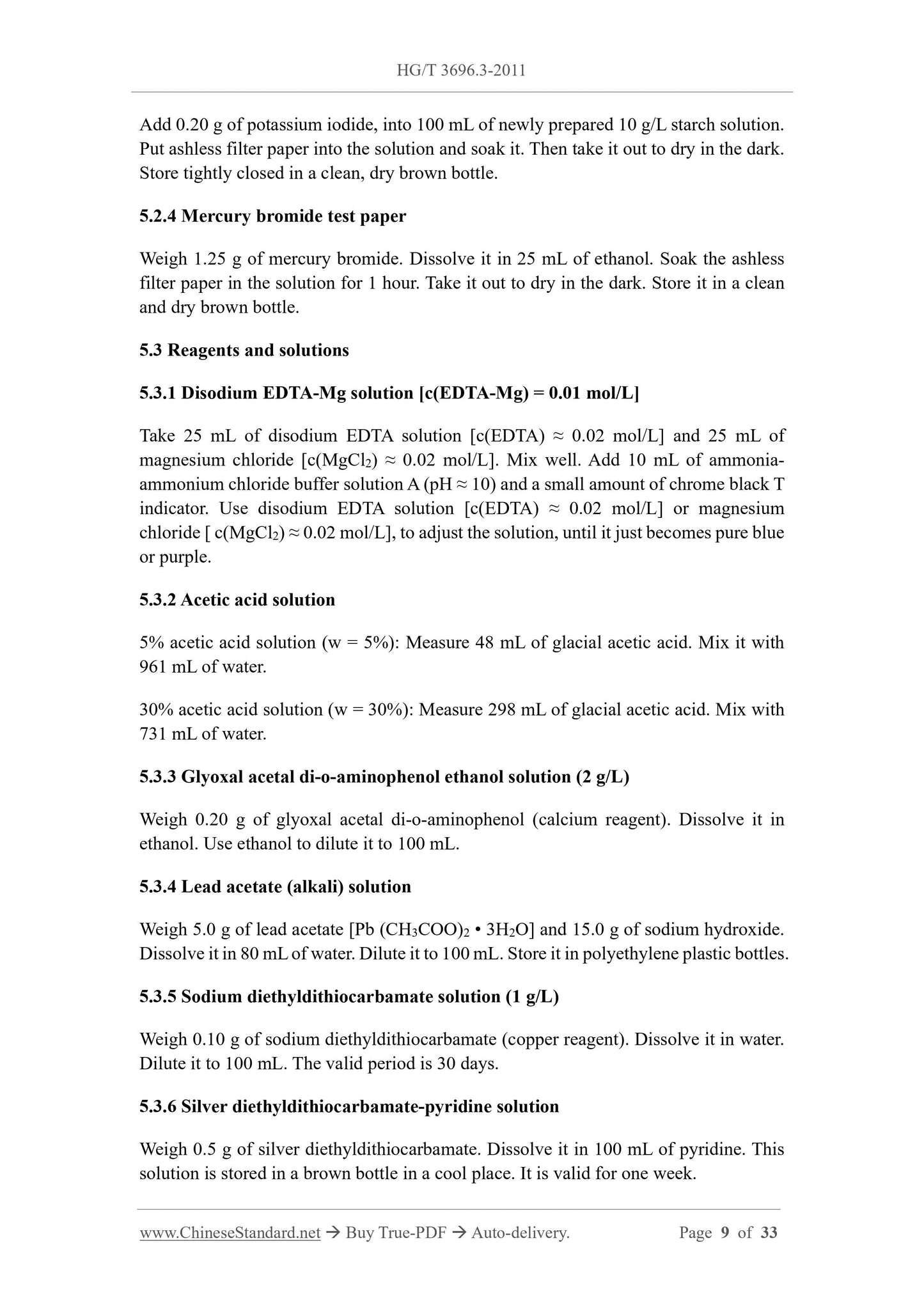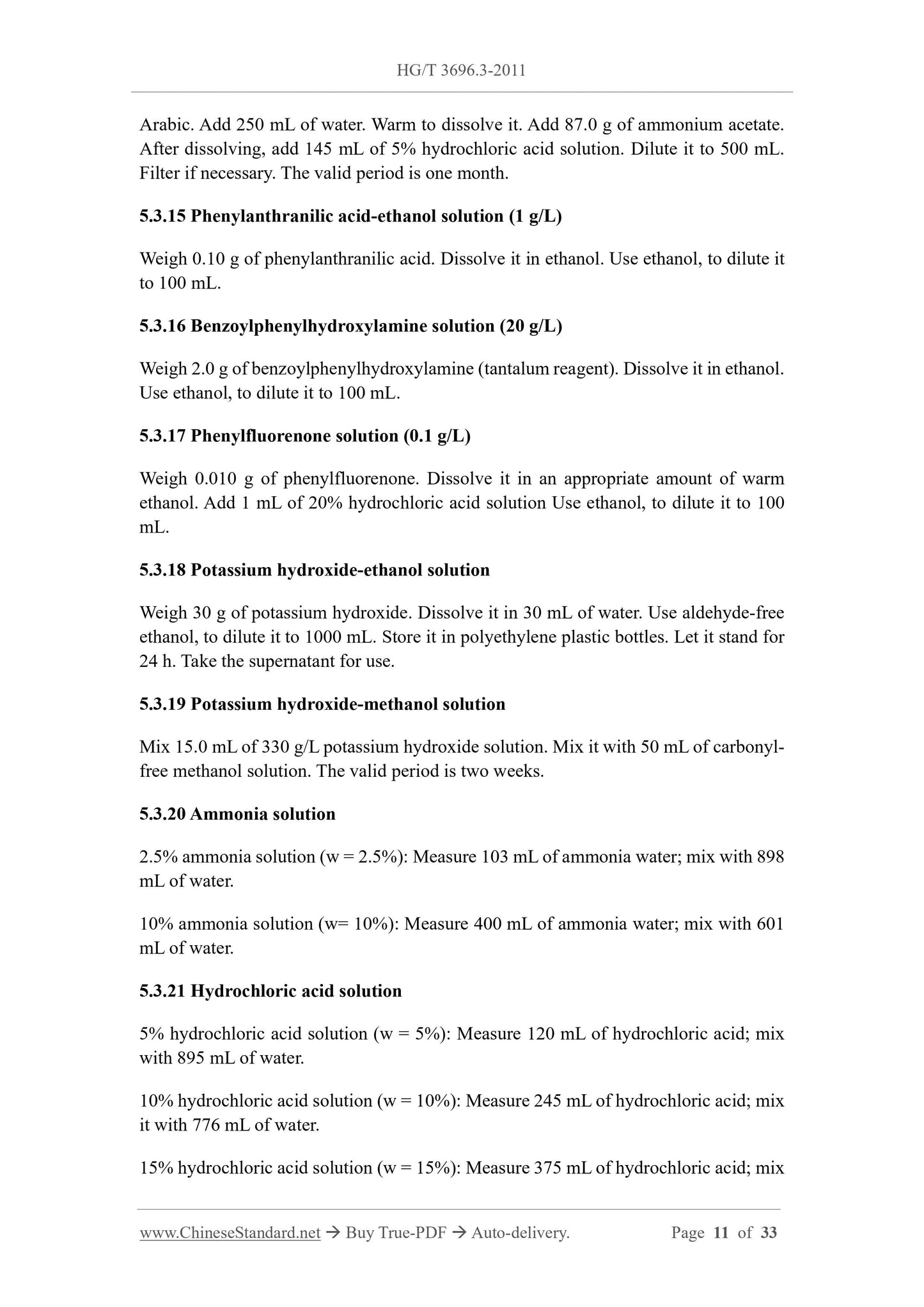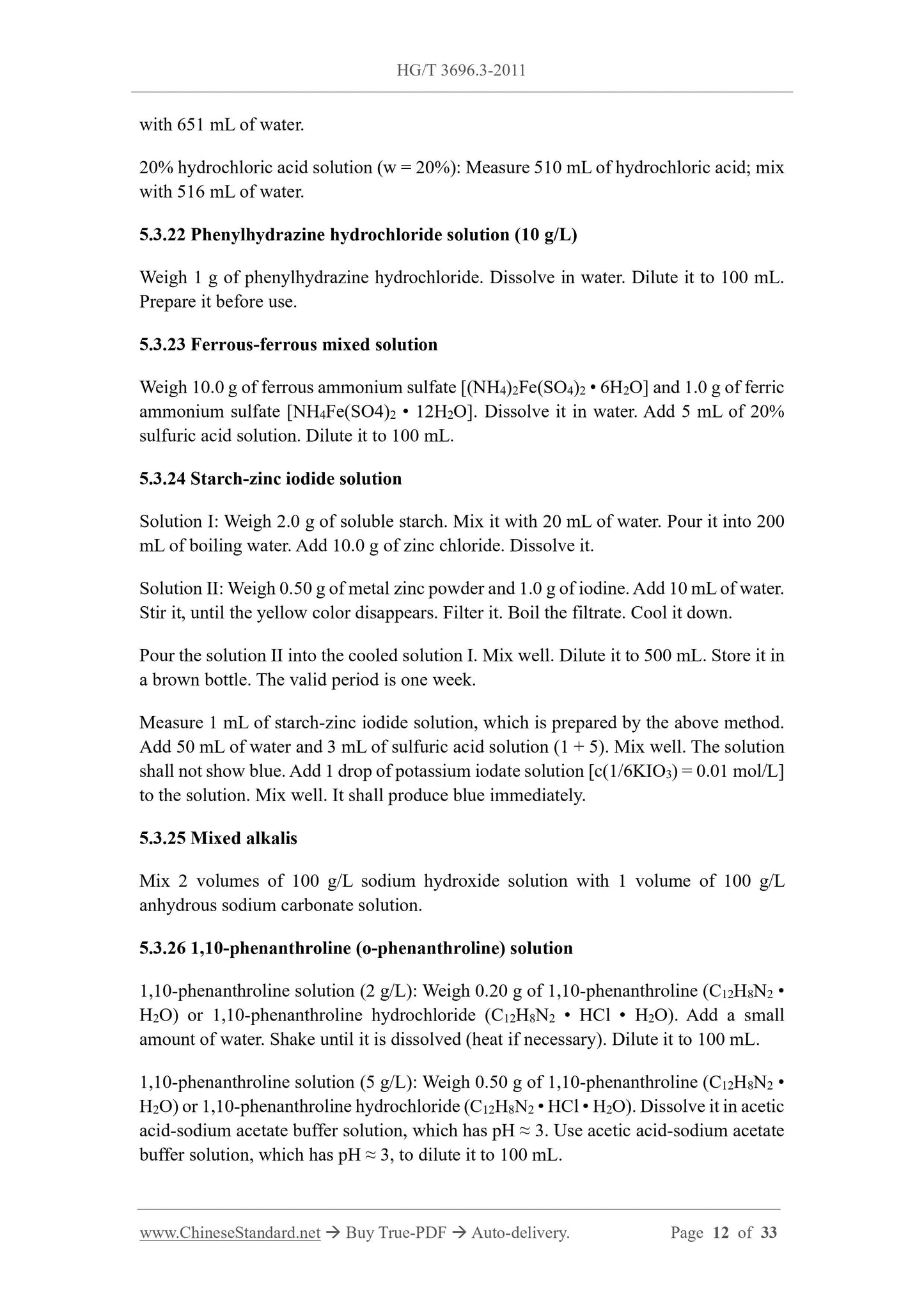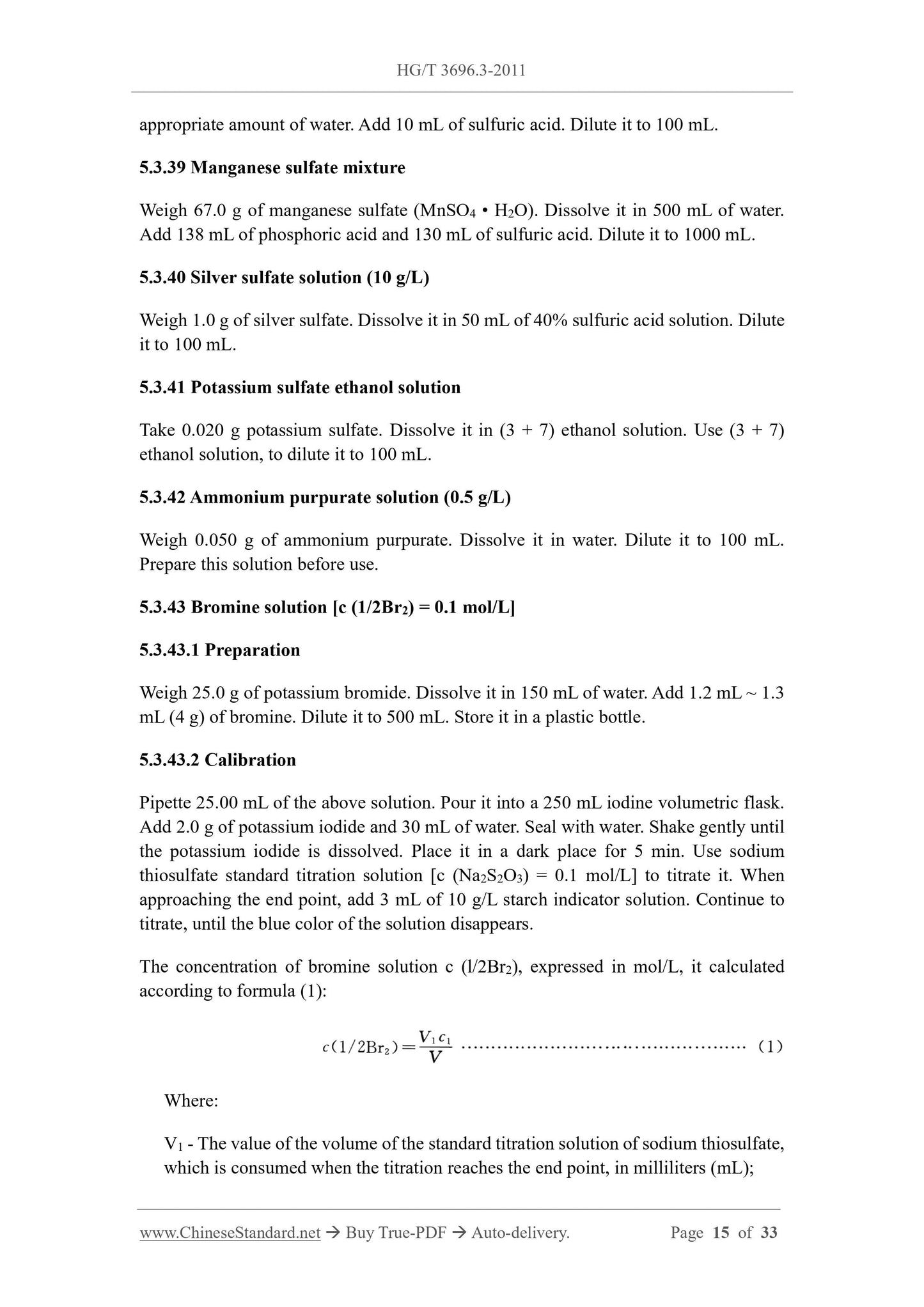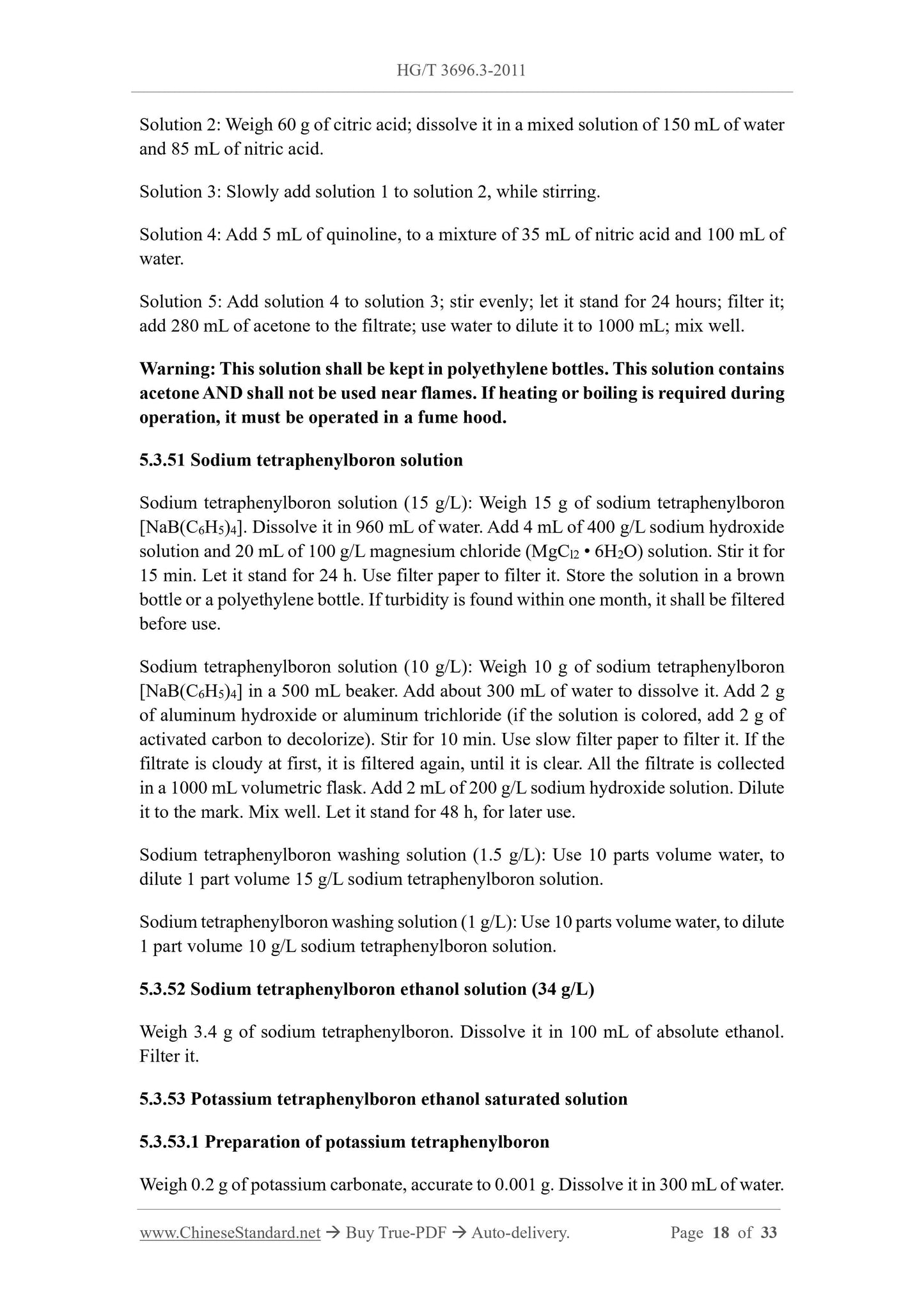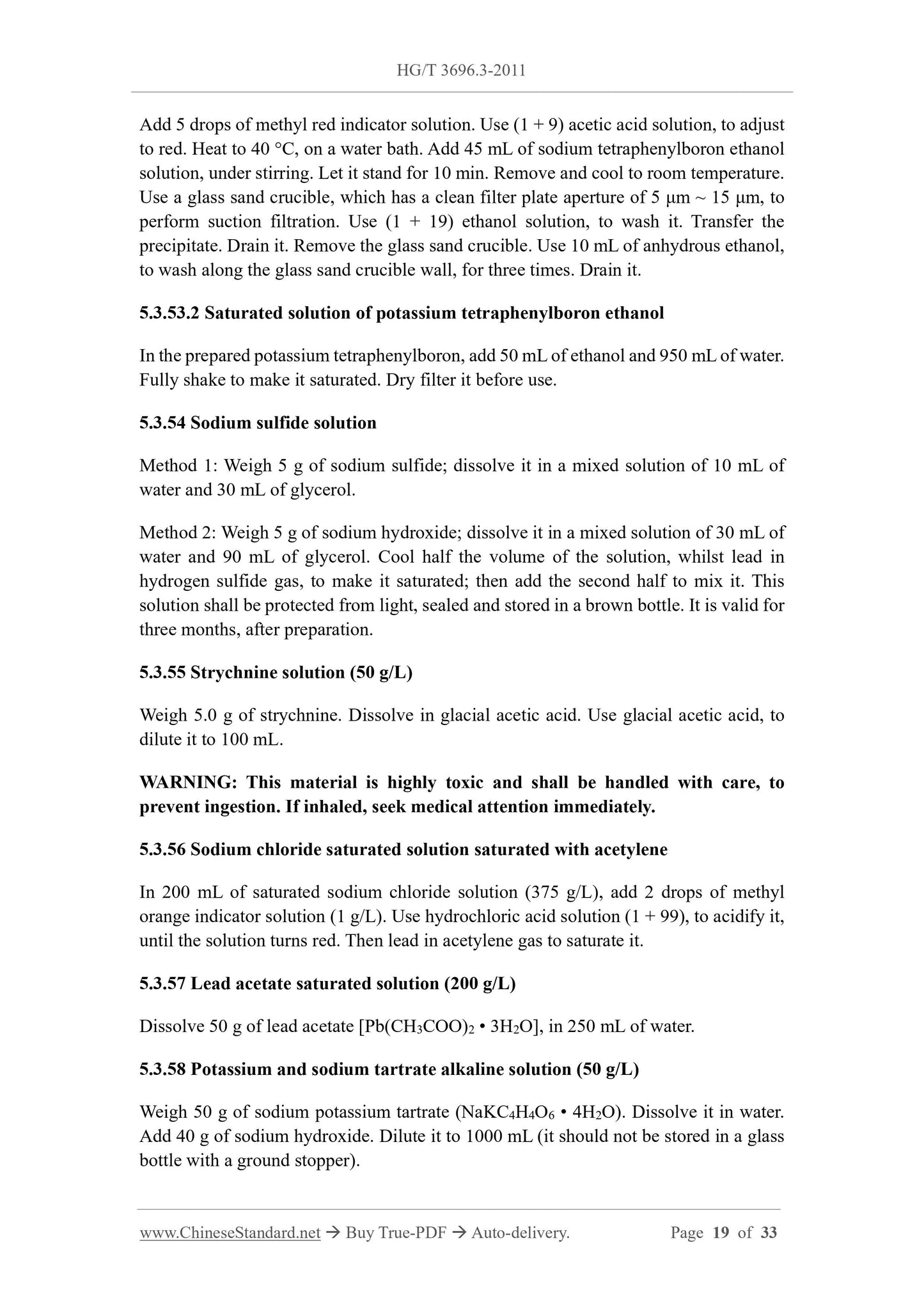1
/
of
12
PayPal, credit cards. Download editable-PDF & invoice in 1 second!
HG/T 3696.3-2011 English PDF (HGT3696.3-2011)
HG/T 3696.3-2011 English PDF (HGT3696.3-2011)
Regular price
$415.00 USD
Regular price
Sale price
$415.00 USD
Unit price
/
per
Shipping calculated at checkout.
Couldn't load pickup availability
Delivery: 3 seconds. Download true-PDF + Invoice.
Get QUOTATION in 1-minute: Click HG/T 3696.3-2011
Historical versions: HG/T 3696.3-2011
Preview True-PDF (Reload/Scroll if blank)
HG/T 3696.3-2011: Inorganic chemicals for industrical use. Preparations of standard and reagent solutions for chemical analysis. Part 3: Preparations of reagent solutions
HG/T 3696.3-2011
CHEMICAL INDUSTRY STANDARD OF
THE PEOPLE’S REPUBLIC OF CHINA
ICS 71.060.01;71.060.99
G 10
Filing No.: 34583-2012
Replacing HG/T 3696.3-2002
Inorganic chemicals for industrial use - Preparation of
standard and reagent solutions for chemical analysis - Part
3: Preparations of reagent solutions
ISSUED ON: DECEMBER 20, 2011
IMPLEMENTED ON: JULY 01, 2012
Issued by: Ministry of Industry and Information Technology of PRC
Table of Contents
Foreword ... 3
1 Scope ... 5
2 Normative references ... 5
3 Warning ... 5
4 General provisions ... 5
5 Preparation method ... 6
Index ... 27
Inorganic chemicals for industrial use - Preparation of
standard and reagent solutions for chemical analysis - Part
3: Preparations of reagent solutions
1 Scope
This standard specifies the preparation of preparations, products, reagents, solutions,
buffer solutions, indicators, indicator solutions, which are commonly used in the
chemical analysis of inorganic chemical products.
This standard applies to the preparation of preparations and products, which are
required for chemical analysis of inorganic chemical products. It can also be used for
chemical analysis of other chemical products.
2 Normative references
The following documents are essential to the application of this document. For the dated
documents, only the versions with the dates indicated are applicable to this document;
for the undated documents, only the latest version (including all the amendments) is
applicable to this standard.
GB/T 6682-2008 Water for analytical laboratory use - Specification and test
methods
GB/T 9733 Chemical reagent - General method for the determination of carbonyl
compounds
3 Warning
Some of the reagents used in the preparation method of this Part of are toxic or
corrosive, so the operator must be careful! If splashed on the skin, rinse
immediately with water. If serious, seek medical attention immediately.
4 General provisions
4.1 The water, which is used in this Part, refers to the grade-3 water, which is specified
in GB/T 6682-2008, unless other requirements are specified.
4.2 The purity of the reagents, which are used in this Part, shall be above analytical
grade.
4.3 If the concentration is expressed in unit mass and volume, the concentration is
expressed in grams per liter (g/L).
4.4 When the solution appears turbid, precipitated, changes in color or exceeds the
specified limit, it shall be prepared again.
4.5 Unless otherwise specified, the solutions in this Part refer to aqueous solutions;
dilution refers to dilution with water.
4.6 Unspecified ethanol, which is used in this Part, is commercially available 95%
ethanol.
5 Preparation method
5.1 Preparation
5.1.1 Carbon dioxide-free water
Pour water into the flask. Boil it for 10 min. Immediately use a rubber stopper, which
is equipped with a soda lime tube, to plug it tightly. Let it stand for cooling. The service
life is one week.
5.1.2 Oxygen-free water
Pour water into the flask. Boil it for 1 h. Immediately use a rubber stopper, which is
equipped with a glass conduit, to plug it tightly. The conduit is connected to a washing
bottle, which contains 100 g/L pyrogallic acid alkaline solution. Cool it down. The
service life is 2 days.
5.1.3 Ammonia-free water
Take 2 parts of strong basic anion exchange resin and 1 part of strong acid cation
exchange resin. Fill them in an exchange column, which has a diameter of 3 cm and a
length of 50 cm, in turn. Pass water through the exchange column, at a flow rate of 3
mL/min ~ 5 mL/min. The service life is one week.
5.1.4 Ammonia-free sodium hydroxide solution
Inject the sodium hydroxide solution of the required concentration into the flask. Boil
if for 30 min. Use a rubber stopper of the safety funnel (ring-neck double-ball), which
contains (1 + 4) sulfuric acid solution (see Figure 1). Cool it. Use an ammonia-free
water to dilute it to original volume.
The sulfur dioxide gas is passed into the water, at normal temperature 15 °C ~ 25 °C,
until saturated. Prepare it before use.
5.1.7 Saturated hydrogen sulfide water
Pass hydrogen sulfide gas into carbon dioxide-free water, until saturated. Prepare it
before use.
5.1.8 Aqua regia
Slowly pour 1 volume of nitric acid into 3 volumes of hydrochloric acid. Mix well.
Prepare it before use.
5.1.9 Methanol without carbonyl groups
Measure 2000 mL of methanol. Pour it into a 3000 mL distillation flask. Add 10.0 g of
2,4-dinitrophenylhydrazine and 0.5 mL of hydrochloric acid. Reflux on a water bath for
2 h. Heat for distillation. Discard the first 50 mL of distillate. Collect the distillate. Store
it in a brown stoppered bottle. The carbonyl-free methanol, which is prepared by the
above method, shall be determined, according to the provisions of GB/T 9733; the
carbonyl content shall not exceed 0.001%.
5.1.10 Aldehyde-free ethanol
Measure 2000 mL of ethanol. Pour it into a 3000 mL distillation flask. Add 10.0 g of
2,4-dinitrophenylhydrazine and 0.5 mL of hydrochloric acid. Reflux on a water bath for
2 hours. Heat to evaporate it. Discard the initial 50 mL of distillate. Collect the distillate.
Store it in a brown stoppered bottle.
Take 5 mL of aldehyde-free ethanol, which is prepared by the above method. Add 5 mL
of water. Cool it to 20 °C. Add 2 mL of magenta-sulfurous acid solution. Leave it for
10 min. There shall be no obvious red color.
5.2 Products
5.2.1 Lead acetate cotton
Take absorbent cotton. Soak it in 50 g/L lead acetate [Pb(CH3COO)2 • 3H2O] solution.
Remove excess solution. Dry it. Store it in an airtight bottle.
5.2.2 Calcium and magnesium-free sodium chloride
Mix 1 volume of the saturated solution of guaranteed pure sodium chloride with 1
volume of dehydrated ethanol. Stir it continuously, until no crystallization appears.
Carry out suction filtration. Dry the crystallization at 105 ° C ~ 110 ° C. Prepare for use.
5.2.3 Starch-potassium iodide test paper
Add 0.20 g of potassium iodide, into 100 mL of newly prepared 10 g/L starch solution.
Put ashless filter paper into the solution and soak it. Then take it out to dry in the dark.
Store tightly closed in a clean, dry brown bottle.
5.2.4 Mercury bromide test paper
Weigh 1.25 g of mercury bromide. Dissolve it in 25 mL of ethanol. Soak the ashless
filter paper in the solution for 1 hour. Take it out to dry in the dark. Store it in a clean
and dry brown bottle.
5.3 Reagents and solutions
5.3.1 Disodium EDTA-Mg solution [c(EDTA-Mg) = 0.01 mol/L]
Take 25 mL of disodium EDTA solution [c(EDTA) ≈ 0.02 mol/L] and 25 mL of
magnesium chloride [c(MgCl2) ≈ 0.02 mol/L]. Mix well. Add 10 mL of ammonia-
ammonium chloride buffer solution A (pH ≈ 10) and a small amount of chrome black T
indicator. Use disodium EDTA solution [c(EDTA) ≈ 0.02 mol/L] or magnesium
chloride [ c(MgCl2) ≈ 0.02 mol/L], to adjust the solution, until it just becomes pure blue
or purple.
5.3.2 Acetic acid solution
5% acetic acid solution (w = 5%): Measure 48 mL of glacial acetic acid. Mix it with
961 mL of water.
30% acetic acid solution (w = 30%): Measure 298 mL of glacial acetic acid. Mix with
731 mL of water.
5.3.3 Glyoxal acetal di-o-aminophenol ethanol solution (2 g/L)
Weigh 0.20 g of glyoxal acetal di-o-aminophenol (calcium reagent). Dissolve it in
ethanol. Use ethanol to dilute it to 100 mL.
5.3.4 Lead acetate (alkali) solution
Weigh 5.0 g of lead acetate [...
Get QUOTATION in 1-minute: Click HG/T 3696.3-2011
Historical versions: HG/T 3696.3-2011
Preview True-PDF (Reload/Scroll if blank)
HG/T 3696.3-2011: Inorganic chemicals for industrical use. Preparations of standard and reagent solutions for chemical analysis. Part 3: Preparations of reagent solutions
HG/T 3696.3-2011
CHEMICAL INDUSTRY STANDARD OF
THE PEOPLE’S REPUBLIC OF CHINA
ICS 71.060.01;71.060.99
G 10
Filing No.: 34583-2012
Replacing HG/T 3696.3-2002
Inorganic chemicals for industrial use - Preparation of
standard and reagent solutions for chemical analysis - Part
3: Preparations of reagent solutions
ISSUED ON: DECEMBER 20, 2011
IMPLEMENTED ON: JULY 01, 2012
Issued by: Ministry of Industry and Information Technology of PRC
Table of Contents
Foreword ... 3
1 Scope ... 5
2 Normative references ... 5
3 Warning ... 5
4 General provisions ... 5
5 Preparation method ... 6
Index ... 27
Inorganic chemicals for industrial use - Preparation of
standard and reagent solutions for chemical analysis - Part
3: Preparations of reagent solutions
1 Scope
This standard specifies the preparation of preparations, products, reagents, solutions,
buffer solutions, indicators, indicator solutions, which are commonly used in the
chemical analysis of inorganic chemical products.
This standard applies to the preparation of preparations and products, which are
required for chemical analysis of inorganic chemical products. It can also be used for
chemical analysis of other chemical products.
2 Normative references
The following documents are essential to the application of this document. For the dated
documents, only the versions with the dates indicated are applicable to this document;
for the undated documents, only the latest version (including all the amendments) is
applicable to this standard.
GB/T 6682-2008 Water for analytical laboratory use - Specification and test
methods
GB/T 9733 Chemical reagent - General method for the determination of carbonyl
compounds
3 Warning
Some of the reagents used in the preparation method of this Part of are toxic or
corrosive, so the operator must be careful! If splashed on the skin, rinse
immediately with water. If serious, seek medical attention immediately.
4 General provisions
4.1 The water, which is used in this Part, refers to the grade-3 water, which is specified
in GB/T 6682-2008, unless other requirements are specified.
4.2 The purity of the reagents, which are used in this Part, shall be above analytical
grade.
4.3 If the concentration is expressed in unit mass and volume, the concentration is
expressed in grams per liter (g/L).
4.4 When the solution appears turbid, precipitated, changes in color or exceeds the
specified limit, it shall be prepared again.
4.5 Unless otherwise specified, the solutions in this Part refer to aqueous solutions;
dilution refers to dilution with water.
4.6 Unspecified ethanol, which is used in this Part, is commercially available 95%
ethanol.
5 Preparation method
5.1 Preparation
5.1.1 Carbon dioxide-free water
Pour water into the flask. Boil it for 10 min. Immediately use a rubber stopper, which
is equipped with a soda lime tube, to plug it tightly. Let it stand for cooling. The service
life is one week.
5.1.2 Oxygen-free water
Pour water into the flask. Boil it for 1 h. Immediately use a rubber stopper, which is
equipped with a glass conduit, to plug it tightly. The conduit is connected to a washing
bottle, which contains 100 g/L pyrogallic acid alkaline solution. Cool it down. The
service life is 2 days.
5.1.3 Ammonia-free water
Take 2 parts of strong basic anion exchange resin and 1 part of strong acid cation
exchange resin. Fill them in an exchange column, which has a diameter of 3 cm and a
length of 50 cm, in turn. Pass water through the exchange column, at a flow rate of 3
mL/min ~ 5 mL/min. The service life is one week.
5.1.4 Ammonia-free sodium hydroxide solution
Inject the sodium hydroxide solution of the required concentration into the flask. Boil
if for 30 min. Use a rubber stopper of the safety funnel (ring-neck double-ball), which
contains (1 + 4) sulfuric acid solution (see Figure 1). Cool it. Use an ammonia-free
water to dilute it to original volume.
The sulfur dioxide gas is passed into the water, at normal temperature 15 °C ~ 25 °C,
until saturated. Prepare it before use.
5.1.7 Saturated hydrogen sulfide water
Pass hydrogen sulfide gas into carbon dioxide-free water, until saturated. Prepare it
before use.
5.1.8 Aqua regia
Slowly pour 1 volume of nitric acid into 3 volumes of hydrochloric acid. Mix well.
Prepare it before use.
5.1.9 Methanol without carbonyl groups
Measure 2000 mL of methanol. Pour it into a 3000 mL distillation flask. Add 10.0 g of
2,4-dinitrophenylhydrazine and 0.5 mL of hydrochloric acid. Reflux on a water bath for
2 h. Heat for distillation. Discard the first 50 mL of distillate. Collect the distillate. Store
it in a brown stoppered bottle. The carbonyl-free methanol, which is prepared by the
above method, shall be determined, according to the provisions of GB/T 9733; the
carbonyl content shall not exceed 0.001%.
5.1.10 Aldehyde-free ethanol
Measure 2000 mL of ethanol. Pour it into a 3000 mL distillation flask. Add 10.0 g of
2,4-dinitrophenylhydrazine and 0.5 mL of hydrochloric acid. Reflux on a water bath for
2 hours. Heat to evaporate it. Discard the initial 50 mL of distillate. Collect the distillate.
Store it in a brown stoppered bottle.
Take 5 mL of aldehyde-free ethanol, which is prepared by the above method. Add 5 mL
of water. Cool it to 20 °C. Add 2 mL of magenta-sulfurous acid solution. Leave it for
10 min. There shall be no obvious red color.
5.2 Products
5.2.1 Lead acetate cotton
Take absorbent cotton. Soak it in 50 g/L lead acetate [Pb(CH3COO)2 • 3H2O] solution.
Remove excess solution. Dry it. Store it in an airtight bottle.
5.2.2 Calcium and magnesium-free sodium chloride
Mix 1 volume of the saturated solution of guaranteed pure sodium chloride with 1
volume of dehydrated ethanol. Stir it continuously, until no crystallization appears.
Carry out suction filtration. Dry the crystallization at 105 ° C ~ 110 ° C. Prepare for use.
5.2.3 Starch-potassium iodide test paper
Add 0.20 g of potassium iodide, into 100 mL of newly prepared 10 g/L starch solution.
Put ashless filter paper into the solution and soak it. Then take it out to dry in the dark.
Store tightly closed in a clean, dry brown bottle.
5.2.4 Mercury bromide test paper
Weigh 1.25 g of mercury bromide. Dissolve it in 25 mL of ethanol. Soak the ashless
filter paper in the solution for 1 hour. Take it out to dry in the dark. Store it in a clean
and dry brown bottle.
5.3 Reagents and solutions
5.3.1 Disodium EDTA-Mg solution [c(EDTA-Mg) = 0.01 mol/L]
Take 25 mL of disodium EDTA solution [c(EDTA) ≈ 0.02 mol/L] and 25 mL of
magnesium chloride [c(MgCl2) ≈ 0.02 mol/L]. Mix well. Add 10 mL of ammonia-
ammonium chloride buffer solution A (pH ≈ 10) and a small amount of chrome black T
indicator. Use disodium EDTA solution [c(EDTA) ≈ 0.02 mol/L] or magnesium
chloride [ c(MgCl2) ≈ 0.02 mol/L], to adjust the solution, until it just becomes pure blue
or purple.
5.3.2 Acetic acid solution
5% acetic acid solution (w = 5%): Measure 48 mL of glacial acetic acid. Mix it with
961 mL of water.
30% acetic acid solution (w = 30%): Measure 298 mL of glacial acetic acid. Mix with
731 mL of water.
5.3.3 Glyoxal acetal di-o-aminophenol ethanol solution (2 g/L)
Weigh 0.20 g of glyoxal acetal di-o-aminophenol (calcium reagent). Dissolve it in
ethanol. Use ethanol to dilute it to 100 mL.
5.3.4 Lead acetate (alkali) solution
Weigh 5.0 g of lead acetate [...
Share
